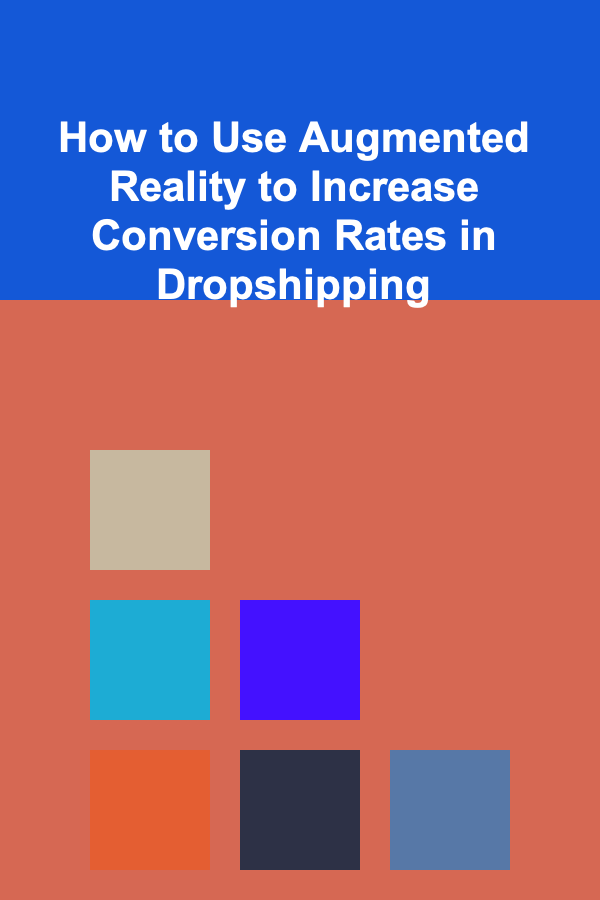
How to Use Augmented Reality to Increase Conversion Rates in Dropshipping
ebook include PDF & Audio bundle (Micro Guide)
$12.99$6.99
Limited Time Offer! Order within the next:

The world of e-commerce is evolving rapidly, with new technologies offering fresh ways to engage customers and boost sales. One such technology that has gained significant traction in recent years is Augmented Reality (AR) . This technology overlays digital information onto the physical world, offering users a more immersive and interactive experience. In the context of dropshipping, integrating AR into your online store can provide a competitive edge, helping you increase conversion rates, reduce returns, and enhance customer satisfaction.
This article explores how augmented reality can be used effectively in dropshipping to drive better results. We will break down actionable strategies, from understanding the technology to implementing it in your store and measuring its success.
Understanding Augmented Reality (AR)
Before diving into its application for dropshipping, it's important to understand what augmented reality is. AR is a technology that superimposes computer-generated images, sounds, or other sensory inputs onto the real-world environment in real time. It enhances a user's perception of the physical world by adding digital elements, which can significantly improve online shopping experiences.
For example, when a customer browses a product on your e-commerce store, AR could allow them to see how the item would look in their own environment, on their body, or with other items in their home.
AR in dropshipping can be especially effective since it bridges the gap between the limitations of traditional online shopping (where customers can't touch, feel, or try products) and the need for a more personalized and informative buying experience.
How AR Enhances the Dropshipping Experience
A. Virtual Product Trials
One of the most powerful uses of AR in dropshipping is virtual product trials. By allowing customers to see how a product fits into their lives before purchasing, you can make them more confident in their decision.
- Furniture & Home Decor: For a furniture or home decor dropshipping business, AR can allow customers to place virtual pieces of furniture in their rooms, helping them visualize the product's scale and design. Apps like IKEA Place are a prime example of this approach.
- Fashion & Accessories: For apparel or accessories, AR can let customers virtually try on clothes, shoes, or accessories. Virtual try-ons, like those offered by companies such as Warby Parker (glasses) or ASOS (clothing), help customers see how the product will look on them, reducing the uncertainty of fit and style.
B. Reducing Product Returns
In dropshipping, high return rates are a significant challenge. Customers often return items because the product doesn't meet their expectations, whether in terms of size, fit, or appearance. By integrating AR into your shopping experience, you can help customers make better purchasing decisions, which can dramatically lower the likelihood of returns.
For instance, when customers use AR to see how a pair of shoes fits on their feet or how a sofa looks in their living room, they are more likely to make a purchase that matches their expectations. This not only reduces the number of returns but also increases customer satisfaction.
C. Improved Engagement
AR offers an interactive shopping experience that traditional product pages cannot match. It creates a more engaging, fun, and personalized shopping experience, which can lead to increased customer time spent on your site. Engaged customers are more likely to make a purchase.
- Interactive Product Information: AR allows you to present information about your products in an immersive way. For example, a user could point their phone at a product, and interactive elements (like videos or 3D models) could pop up, explaining its features and benefits in greater detail.
- Gamified Experiences: Incorporating gamification into your AR experiences can further increase user engagement. For example, customers could unlock special offers or discounts by interacting with AR features or completing challenges related to your products.
D. Building Trust Through Transparency
Transparency is key in online shopping, and AR can help by giving customers a better understanding of the products they are considering. Instead of relying solely on static images or vague product descriptions, AR allows customers to explore the product from all angles.
For example, 360-degree views or product demos using AR allow users to get a clear and realistic sense of the product. This builds trust, as customers feel more confident in their purchase when they can experience the product more thoroughly before buying.
How to Implement AR in Your Dropshipping Store
Now that we understand the benefits of using AR, let's explore actionable ways to implement it in your dropshipping business.
A. Choose the Right AR Platform
There are several AR tools and platforms that you can use to integrate AR into your store. Some popular options include:
- Shopify AR: If you're using Shopify for your dropshipping store, you can easily integrate AR through its native AR functionality. Shopify's AR tool allows you to upload 3D models of products, which customers can view in AR on their mobile devices.
- Augment: Augment allows you to create 3D product models and integrate them into your website. You can customize the AR experience by enabling customers to view your products in real-time through their mobile phones.
- 3D Cloud: 3D Cloud by Marxent offers advanced 3D and AR visualization solutions, especially useful for home furnishings, decor, and other visually complex products.
- VNTANA: VNTANA offers AR and 3D solutions for e-commerce stores. It's designed to work seamlessly with popular platforms like Shopify, Magento, and WooCommerce.
When selecting an AR tool, make sure it aligns with your specific product range and the type of experience you want to offer your customers. Some platforms focus on product visualization, while others provide more immersive experiences.
B. Create High-Quality 3D Models
In order to offer AR functionality, you will need high-quality 3D models of your products. These models serve as the foundation for your AR experience. If you're dropshipping products from suppliers, you may need to work with your suppliers or a third-party 3D artist to create detailed models of your products.
- Use Product Photos: If 3D models aren't feasible, some AR platforms allow you to upload detailed product images and offer basic AR functionality. However, this won't provide as immersive an experience as 3D models.
- Outsource 3D Modeling: If you're not familiar with 3D modeling, you can outsource this task to professional designers. Websites like Fiverr or Upwork have talented freelancers who specialize in creating 3D models for e-commerce.
C. Optimize for Mobile Devices
Since most AR experiences are accessed through mobile devices, ensure that your website and AR features are mobile-optimized. AR requires high-performance rendering and smooth interactions, so your website must load quickly, and the AR experience must be seamless.
- Test Across Devices: Make sure your AR features work smoothly across different devices, including iOS and Android devices. Testing on multiple devices will ensure that the AR experience is universally accessible.
- Simplify Navigation: The AR feature should be easy to use. Simplify navigation by providing clear instructions and intuitive interfaces. The smoother the AR experience, the more likely customers are to engage with it.
D. Promote AR Features to Customers
Once you've integrated AR into your store, it's important to promote the feature to your customers. Not everyone will know that AR is available, so you need to actively encourage its use.
- Highlight AR on Product Pages: On product pages, include a call to action encouraging customers to "Try it in AR" or "See it in your space." This draws attention to the AR feature and prompts customers to engage with it.
- Use Social Media: Social media platforms like Instagram and Facebook can be powerful tools to showcase your AR features. Share posts, stories, or videos demonstrating how customers can use AR to enhance their shopping experience.
- Email Campaigns: Send out email newsletters informing your subscribers about your new AR feature. Include a step-by-step guide or video showing how they can use the technology to visualize products in their homes or try them on virtually.
Measuring Success and ROI
To ensure that AR is effectively increasing your conversion rates and improving customer satisfaction, you need to track its performance.
A. Key Metrics to Monitor
- Conversion Rate: Measure how many visitors who engage with your AR features make a purchase versus those who do not.
- Average Order Value (AOV): Track if customers who use AR tend to purchase more expensive items or bundle products together.
- Engagement Metrics: Track how long users engage with your AR features. Are they spending more time on product pages after interacting with AR?
- Return Rates: Compare return rates of customers who used AR to those who didn't. A lower return rate suggests that AR is helping customers make better purchasing decisions.
B. A/B Testing
You can also run A/B tests to compare the performance of pages with AR features to those without. By analyzing the differences in customer behavior, you can refine your AR implementation to maximize its effectiveness.
Conclusion
Integrating Augmented Reality into your dropshipping store can significantly enhance the customer experience, increase conversion rates, and reduce product returns. By offering virtual product trials, reducing uncertainty, and building trust through immersive experiences, you can set your store apart from the competition.
However, it's important to approach AR integration strategically---select the right tools, optimize your website, and actively promote your AR features to customers. By continuously monitoring results and refining your approach, you can unlock the full potential of AR to drive higher sales and create a more engaging shopping experience.
Reading More From Our Other Websites
- [Organization Tip 101] How to Make the Most of a Narrow Entryway
- [Personal Care Tips 101] How to Use Hair Oil to Improve Hair Texture
- [Personal Care Tips 101] How to Choose Face Oil for Your Daily Skincare Routine
- [Metal Stamping Tip 101] Best Metal Stamping for Custom Awards & Engrined Trophies -- Precision & Quality
- [Home Family Activity 101] How to Set Up a Family Treasure Hunt for Exciting Adventures
- [Personal Finance Management 101] How to Create a Budget Spreadsheet for Easy Financial Tracking
- [Digital Decluttering Tip 101] From Chaos to Calm: How to Build a Sustainable Inbox Zero Routine
- [Personal Investment 101] How to Use Financial Planning Software to Optimize Your Investment Strategy
- [Whitewater Rafting Tip 101] River Rush: Exploring Untamed Landscapes Through White-Water Rafting
- [Home Space Saving 101] How to Declutter Your Home in 30 Days: A Room-by-Room Space-Saving Challenge

How to Create a Time Management Checklist for Evening Routines
Read More
How to Soundproof Your Kids' Playroom for Quiet Time
Read More
How to Understand Art History for Inspiration
Read More
How To Prepare for Remote Job Interviews
Read More
How to Minimize Redness and Irritation
Read More
How To Brew Popular IPA Styles: A Comprehensive Guide
Read MoreOther Products

How to Create a Time Management Checklist for Evening Routines
Read More
How to Soundproof Your Kids' Playroom for Quiet Time
Read More
How to Understand Art History for Inspiration
Read More
How To Prepare for Remote Job Interviews
Read More
How to Minimize Redness and Irritation
Read More